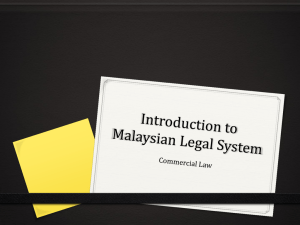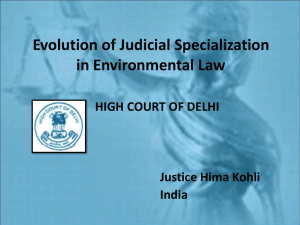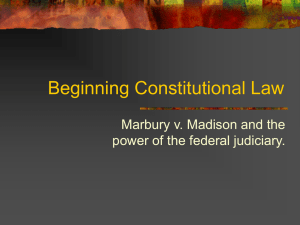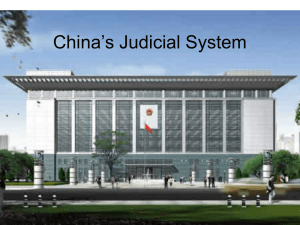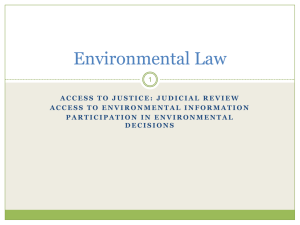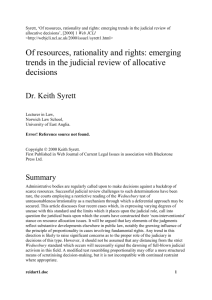Grounds of Judicial Review
advertisement
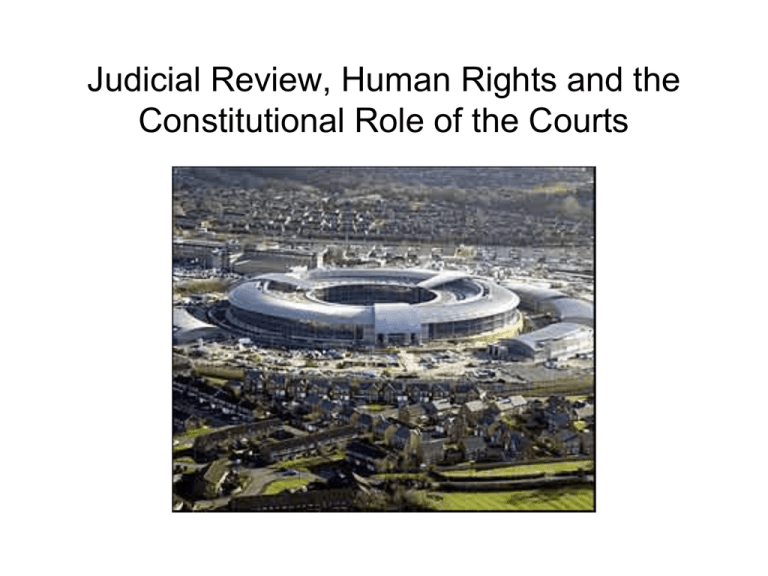
Judicial Review, Human Rights and the Constitutional Role of the Courts The Grievance chain • Idea that remedies are available at different levels • Strictly informal e.g. citizen’s advice bureau, law centres, and citizen’s charter. • More formal but not strictly legal e.g. ombudsman with investigatory powers but can only recommend remedies • Tribunals as administrative remedies – large case load, diverts issues from courts and can give legal remedies e.g. compensation, unfair dismissal. • Courts e.g. judicial review : formal remedy of last resort. Typically empowered to quash decisions of public bodies. Introduction • The emergence of judicial review is linked to the Diceyan notion of the rule of law. • There will be reference to the distinction between review and appeal and the special nature of public law remedies. • The significance of changes in judicial policy with reference to the Wednesbury case, Ridge v Baldwin and the GCHQ case. • The impact of the Human Rights Act • Discussion of selection of case which illustrate the increased profile of the courts. Examples of JR cases • challenge to an attempt by a local authority to ban stag hunting ex parte Fewings [1995]. • whether a woman could use her late husband’s sperm ex parte Blood [1997] • Deprivation of constitutional right of access to the courts ex parte Whitam [1998] • Whether bids for the national lottery had been conducted fairly by the statutory regulator, OFLOT: see R v The National Lottery Commission, ex parte Camelot Group PLC [2001] EMLR 43 • challenge to the admissions policy of state aided jewish faith school on the grounds that this was discriminatory on grounds of ethnicity: R (on the application of E) (Respondent) v Governing Body of JFS and the Admissions Appeal Panel of JFS (Appellants) [2009] Cooper v Wandsworth Board of Works (1863) 14 CB (NS) 180 '...the justice of the common law will supply the omission of the legislature'. Ridge v Baldwin [1964] Chief constable dismissed without a hearing. This is regarded as the leading case. Lord Reid indicated that these rules will be applied on a wide basis, both as to content and context. The claimant has a common law right to be treated fairly where rights are affected, as here. Put differently, a legitimate expectation re procedural fairness is recognised, now reinforced by Article 6 ECHR Judicial review and the role of the courts The fundamental assumption accepting the Diceyan view of the constitution is that the courts exercise a control function, and that this function is now performed using the judicial review procedure. Judicial review is NOT an appeals procedure. Appeals are often routinely available to courts or tribunals. An aggrieved citizen who wishes to challenge a decision must first exhaust existing avenues. The courts under the JR procedure operate to consider whether the public authority has acted lawfully. The remedies are not designed to compensate victims or guarantee final outcomes but simply to ensure the legality of decisions taken. Typically unlawful decisions will be set aside. JR Remedies and Procedural Reform Lord Diplock developed the exclusivity principle because he recognised the special character of public law remedies. • Quashing Order/Certiorari has the effect of quashing an ultra vires decision. If the remedy is granted an ultra vires decision will be rendered VOID. • Mandatory Order/Mandamus - instructs (mandates) an authority to do its statutory duty, which may be to exercise its statutory discretion lawfully in the future • Prohibiting Order /Prohibition - serves to prohibit the authority from acting unlawfully in the future. Remedies contd • Declaration - not imposed by the court but states what the legal position is between the parties. Often sufficient for public bodies who are not prepared to act unlawfully. • Injunction (equitable remedy) that usually prevents a body from acting. • Damages only available in limited circumstances in public law. The reach of public law in a contracting state JR is an exclusively public law remedy, recognised by Lord Diplock in O'Reilly v Mackman [1982]. Following the introduction of new procedures JR must be used. Key decision - R v Panel on Takeovers and Mergers, ex parte Datafin [1987] not only source of power but the nature of the functions. Contrast other cases especially where contractual relationship exists: The Jockey Club R v Disciplinary Committee of the Jockey Club, ex parte Aga Khan [1993]. Liberalisation of the rules of standing Rules of standing: RSC Order 53 r.3(7) that the court shall not grant leave to apply for JR unless the applicant has a 'sufficient interest' in the matter to which the application relates IRC v National Federation of Self-Employed and Small Businesses Ltd [1981] [Fleet Street Casuals (or Mickey Mouse) case] Challenge to a settlement with printers reached by the inland revenue by a group with no direct interest in the matter. Recognised that standing should not be a general impediment to using the JR procedure. Representative groups routinely represented in JR cases. The Wednesbury Decision Associated Provincial Picture Houses v Wednesbury Corporation [1948] The Sunday Entertainments Act 1932 states it is “to permit and regulate the opening and use of places on Sundays for certain entertainments…”. It legalised such Sunday openings as had been purportedly permitted earlier and prescribed a procedure by which any licensing authority could apply for an Order allowing Sunday opening in that licensing area. Sunday Entertainments Act 1932 legalised Sunday opening of cinema under conditions that ‘the authority think fit to impose’. WC inserted condition that no children under 15 admitted whether or not with adult. Objectionable to cinema owners. There was much concern around this time about the impact of the cinema on children. The Home Office and the Department of Education set up a Departmental Committee in 1947 to consider the effects of cinema attendance on children with a view to seeing whether changes were necessary to conditions of admission. Cinema going in the 1940s The blanket prohibition on cinema admission of children all day on the Sabbath can only mean that Wednesbury Corporation an elected local council in a town with a strong tradition of religious observance thought that children (no doubt, with their parents) should do other things on the Sabbath. On the other hand, in an age where 25 million plus of the population went to the cinema at least once a week Gaumont cinemas were horrified by the idea that a decision to ban children would set a precedent for other towns to follow which would dent their profits. A further apparent anomaly was the lack of consistency between the town of Wednesbury which imposed this ban and other neighbouring cities and towns including Birmingham which allowed children to visit cinemas on a Sunday. Lord Greene’s judgment Challenge failed as the condition fell within the discretionary power of the public authority. 1. Authority must have contravened the law. 2. Burden of proof on claimant. 3. Court must not substitute itself for the authority and become a Court of Appeal. 4. Decision could be set aside only because unlawful e.g. relevant and irrelevant considerations not taken account etc or because of unreasonableness of an altogether different type. What is Wednesbury unreasonableness? Warrington LJ in Short v Poole Corporation [1926] Ch 66, 90, 91 gave the example of the red-haired teacher, dismissed because she had red hair. That is unreasonable in one sense. In another sense it is taking into consideration extraneous matters. It is so unreasonable that it might almost be described as being done in bad faith ...'. the courts will only interfere with the exercise of a discretion when an authority has come to a conclusion so unreasonable that no reasonable authority could ever have come to it. The Courts and Resource Allocation R (on the application of Rogers) v Swindon NHS Primary Care Trust and Sec of State for Health [2006] A breast cancer sufferer was denied the drug Herceptin by her local health authority on grounds that it could not afford to fund this treatment. Contested as in breach of Article 2. “ ….‘judges look at the rights of individuals; health managers have to balance the rights of many different patients’. Such opinions … reflect persistent anxieties as to the constitutional and institutional competence of the courts to adjudicate upon polycentric questions, such as those which arise in the context of health care rationing, and are rooted in an overly narrow conception of public law’s function as a vehicle for the preservation of individual autonomy against the collective goals pursued by the organs of the state” (K. Syrett p.669). GCHQ Main grounds explained Judicial activism of the 1960s, reform of procedure and new judicial approach Council for Civil Service Unions v Minister for the Civil Service [1985] challenged the banning of unions at GCHQ by the government, hence GCHQ case: Lord Diplock set out the grounds as follows: 1. Illegality with many sub-grounds 2. Irrationality also termed Wednesbury unreasonableness 3. Procedural impropriety/natural justice Proportionality as a ground was anticipated - it now applies under HRA. Illegality: legal limits on discretionary powers Padfield v Ministry of Agriculture [1968] Limits on discretion even if the power appears to be widely drawn: 'If the minister in any such case so directs’. R v S of S for For Affairs, ex p World Development Movement [1996] Did the Malaysian Pergau Dam project fall under a ‘developmental purpose’. Rose LJ 'Whatever the Secretary of State's intention or purpose may have been, it is, ... , a matter for the courts and not for the Secretary of State to determine whether, on the evidence before the court, the particular conduct was, or was not, within the statutory purpose’. Further in exercising discretion the decision-maker is required to take account of relevant considerations and ignore irrelevant considerations Human Rights Act 1998 and Judicial Review Public authorities are placed under a statutory under s.6 to have regard to the convention rights of citizens. Under the act a breach of convention right by a public authority becomes a ground of review / also a defence to alleged unlawful conduct. The HRA s.3 grants the courts powers to interpret legislation to render it compatible with the convention but it does not allow the courts to invalidate primary legislation. Rather, they have the power under s.4 to issue ‘a declaration of incompatibility’ which draws attention to the breach of the right but leaves it up to Parliament to change the offending law. There is a fast track procedure to enable legislation to be amended. Citizens can still take their case to Strasbourg. Human Rights Act: Proportionality review R v SS for Home Department, ex parte Daly [2001] concerned a challenge to regulations under section 47(2) of the Prison Act Act 1952 allowing the prison authorities to search cells without the prisoner present. A remand prisoner who had private correspondence with his lawyer relating to his trial argued that this rule was unlawful. Lord Steyn stated that a proportionality test would be applied: (a) the legislative objective is sufficiently important to justify limiting a fundamental right; (b) the measures designed to meet the legislative objective are rationally connected to it; (c) the means are no more than is required to accomplish the objective. Held that the policy contained in this rule constituted a breach of Article 8 of the convention since it constituted a disproportionate interference with the prisoner’s rights. The same objective could have been achieved by less intrusive means. A & Others v Home Secretary [2004] (the “Belmarsh detainees” case) • • • • • the indefinite detention under the Anti-Terrorism Crime and Security Act 2001 without trial of a group of non British nationals suspected of being terrorists. This was held to be unlawful The provision to detain contrary to ECHR Art. 5 required a derogation under Art. 15. The derogation would only be valid if strictly required for a public emergency threatening the life of the nation. On this issue a wide margin of appreciation was given by the judges to the government. Held this was a political issue and only the government has access to the security information upon which such a judgment could be made. Lord Hoffman dissented ‘no threat to the life of the nation’. But he measures were discriminatory against foreign nationals and thus contrary to Article 14 of the ECHR. Impact of the Belmarsh Decision • • • • • The Human Rights Act 1998 (Designated Derogation) Order 2001 was quashed on account of its incompatibility with Article 15 ECHR. Although the House of Lords issued a declaration of incompatibility under section 4 of the HRA this declaration could not nullify the legislation directly. The suspects remained in prison. ‘There is no shift to a merits review, but the intensity of review is greater than was previously appropriate’ ‘The speeches of these eight senior judges amount collectively to what is the finest assertion of liberty that has emerged from a British court since at least Entick v Carrington …’ Gearty The Prevention of Terrorism Act 2005 was passed by Parliament in March 2005 and the Act replaces Part IV of the 2001 Act i.e. the power to order indefinite detention without trial on grounds of reasonable suspicion with control orders. Conclusion • Sophisticated grounds of JR have been established under the common law on a case by case basis. • These grounds serve to constrain the discretionary powers of public authorities. • This, in turn, raises important questions relating to placing limits on judicial intervention. The Wednesdbury test imposed a high threshold, keeping the courts from being drawn into the political process. • The HRA and proportionality has tended to increase the profile of the courts. • This raises the question of whether the UK is moving towards a judicial constitution. Should judges be the final arbiters on issues such as resource allocation?


